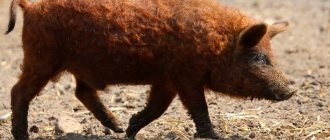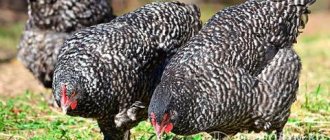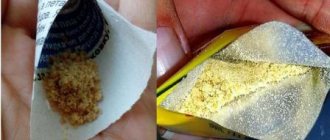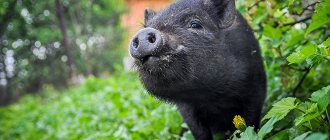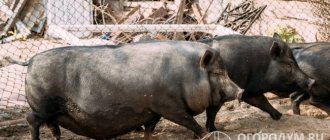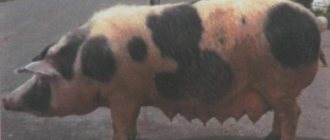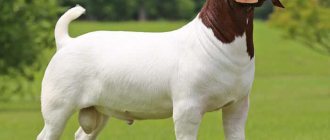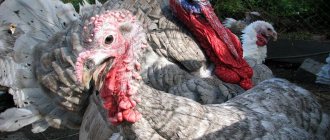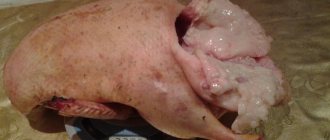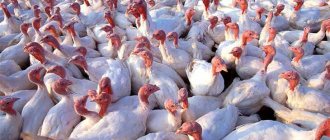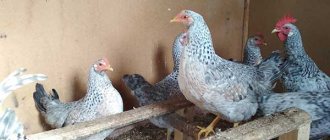Chinese Meishan pigs were developed more than 400 years ago. What is characteristic is that the breed has not changed much since that time. Animals still surprise with their exotic appearance, and also delight the owner with their unpretentiousness to food and high resistance to disease. The Chinese breed is not widespread in Russia, but still some breeders are breeding it.
The Chinese Meishan pig, often called the fold pig.
Description
One of the most popular breeds of Chinese pigs is the Meishan. The animals got their name because of their place of origin - Meishan County. Interestingly, this breed has been known in China for a long time. The characteristics compiled for this breed indicate that it belongs to the taihu (ancient group). Moreover, the Chinese have been raising such pigs for more than four centuries. An important feature of animals of this breed is that they are quite fertile. Scientists note that adults can already have offspring when they reach the age of three months. It is noteworthy that there are quite a lot of piglets in one litter - approximately 14-16. Even though one pig has several babies at once, she can easily feed them all. The fact is that an adult female has 8-12 pairs of nipples at once. In a year, one pig can give birth, as a rule, twice.
An important feature of the Chinese pig of this breed is the specific appearance of the animal. Once you see such an individual, it will no longer be possible to confuse it with some other animal. Adult meishans are quite large in size. Their ears are floppy. There are quite a lot of wrinkles on the pig's face. The head of the animal also has characteristic anatomical features. So, the size of this part of the body is quite large. At the same time, this pig’s snout is short. Even though Meishans are quite large, they can move easily as they have dense and short legs. The animal's belly is saggy.
It is interesting that the skin of the meishan has multiple folds. The skin is covered with rather dense bristles. The color of the skin is dark (usually even black), but the most distal part of the legs and the patch are pinkish in color.
Such Chinese pigs are characterized by quite heavy weight. Usually by the age of eight months they gain about 160 kg. However, some individuals can be much heavier. An important feature of this breed is that the animals have quite a lot of fat in their bodies. The sebaceous layer in the distal part of the body of such a pig is, as a rule, about 3-4.5 cm. Many Chinese prefer to raise Meishan pigs . The fact is that in this country many residents value pork fat more, as well as offal and leather. But pork meat is usually not so valued. Therefore, the anatomical features of the breed contribute to the fact that many Chinese choose it. It is also worth noting that despite the high content of fat mass in the body, meishans have very tasty and aromatic meat.
An important advantage of animals of this breed is that they are quite easy to raise. Such pigs prefer to eat a lot of foods - for example, roughage, various feeds and even some algae. In terms of care, these animals are also unpretentious. The special taste of lard and meat of this breed contributes to the fact that it is valued not only in China, but also in America, and even in some European countries.
Productivity of the Chinese fold pig
For its high productivity, the Meishan pig breed is in high demand.
- Meishan pigs have a lot of lard. It is for the sake of obtaining it that the breed is mainly bred. Salination occurs from a very early age. Even small pigs have a very decent layer of fat, and over time it becomes more and more. The thickness of the fat in the back of the carcass after slaughter reaches 2.5-2.5 cm.
- Meat contains a large amount of fat. But despite this, it is quite tasty.
- Another feature of the Meishan pig is its large internal organs. In China, this quality is highly valued, since offal is more popular there than in Europe.
Meishan pigs have a lot of fat
Today, the Meishan pig breed is bred not only to produce tasty lard. In Europe, these individuals are kept in zoos and similar entertainment places. Scientists are studying the breed to understand the reasons for the high fertility of females. In addition, breeding work is being carried out in the direction of reducing the fat content of meat in pigs.
What are they?
There are different breeds of Asian pigs. In addition to the fold-eared meishan, the Chinese also grow others. So, in this country, some farmers are raising Vietnamese pot-bellied pigs. These animals have a number of features. For example, they are characterized by having fairly strong immunity, as well as fairly high fertility. Jeju black pigs are raised in Korea. However, it is believed that for the first time such animals were brought to this state from China. Many Asians adore these pigs because they value their meat and lard for their good taste. In some restaurants, dishes prepared from such products are considered real delicacies.
Another fairly well-known breed of Chinese pig is the Wuzhishan. However, many pig lovers in China are increasingly choosing these animals less and less.
They note that these pigs are quite small in size (relative to other breeds), as well as relatively low fertility.
Content Rules
The undoubted advantage of the described Chinese pigs is that they are quite easy to raise. Scientists note that such pigs have relatively high levels of immunity. That is why, when raising these animals, you should not be afraid that they will constantly get sick. If you give your pig all the necessary vaccinations on time and take proper care of it, then you don’t need to worry about the animal’s serious illnesses.
Chinese piglets are quite calm by nature. That is why such pigs are recommended to be chosen by people who want to start farming, but do not have sufficient experience in pig farming. However, before purchasing a Meishan or a pig of any other breed, they should definitely study detailed information on how to care for them. It is better to keep such pigs in a separate room. Since these animals are quite strong, it is necessary to create a particularly strong pen for them.
It is important to remember that an adult animal, if it rests its feet on such a fence, can easily tear it down. That is why it is necessary to make a pen in such a way that it is very strong and stable.
Chinese pigs dig the ground. You should definitely remember this when building a place for them to live. Some new farmers think that they can wean their animals off this habit. However, experts note that this simply cannot be done, since in Chinese pigs the need to dig the soil is at the genetic level. Despite the fact that these animals have fairly good health, they should be protected from the cold if possible. It is very important to ensure that the pen in which such pigs will live is not exposed to cold drafts. A good ventilation system is an important condition for keeping such animals. It will minimize the release of toxic fumes from pig feces into the surrounding air.
Fans of Chinese pigs advise choosing fairly durable materials when building a place for the animals to live. For a comfortable, and most importantly, durable enclosure, bricks or even cinder blocks are perfect. These materials also have an important advantage, namely that they have fairly good thermal insulation properties. The size of the “house” for pigs should be sufficient . They should be selected individually, taking into account how many animals will live in such a place. As a rule, one such pig requires at least 2 meters of space.
Growing conditions
Despite the lack of special care requirements, certain points should still be taken into account when breeding Chinese pigs. Speaking about the optimal conditions for their cultivation, it is worth noting a number of requirements that apply to the room where they are planned to be bred:
- There must be a solid concrete foundation under the floor of the building and along the walls. Meishans have a natural habit of tearing up the soil and gnawing boards. Therefore, they can quickly render the barn unusable.
- Strong walls made of brick or foam block. If thin wood is used, they must be additionally insulated so that the barn does not freeze in winter.
- Availability of a high-quality ventilation system.
- Grooves in the floor for drainage of manure and urine.
- High quality heating. This point is especially important for premises where newborn piglets are kept.
- The machines must be made of iron, otherwise the pig will quickly chew through them.
Feeding
Piglets and adults should be fed thoroughly. In order for a Chinese pig to gain weight rapidly, it needs a sufficient amount of food and good care. This animal eats quite a wide variety of foods. So, you can offer the animal feed. It does not disdain seaweed either. Experts advise lovers of Chinese pigs not to forget that these animals are capable of eating roughage. That is why such products should definitely be included in the diet of animals.
In order for the pig to receive enough vitamins, its summer diet must contain various greens. This is why some farmers periodically add alfalfa or clover to their animals’ feed during the summer. For nutritional value, it is recommended to add various grains to the diet - for example, barley or rye . If the pig is slowly gaining weight, then you can add oats or corn to its menu.
Mini pigs
Mini pigs became a separate area of further selection of Meishan pigs. Breeders began breeding them less than half a century ago. Unlike their larger counterparts, miniature meishans are raised exclusively as ornamental animals.
The weight of an adult pig of this variety is only 70 kg. They are kept in an apartment or in a private yard, like a regular dog. Moreover, many owners of such pets testify that they are easy to train and are able to carry out simple commands.
Reference. Thanks to its compactness and charming appearance, the mini-pig is becoming increasingly popular in the world. Some varieties descended from Chinese pigs are now purchased by many celebrities as companion animals.
Breeding
Chinese pigs begin to “create” pairs after reaching full maturity. By this time, adults of both sexes already have pronounced sexual differences. Animals of all ages need to be properly cared for. Caring for young pigs is very important. Experts recommend that you pay attention to the process of transferring a piglet from feeding a sow to a regular diet. They note that during this “transition” to a new feeding style, piglets may change their behavior - for example, they will become sad and eat slightly less. There is no need to be afraid of such changes. During this time, it is important to be patient and continue to properly care for your small animal. After some time, the piglet will get used to the new food and will feel good again. Mother's milk from a Chinese sow has a number of unique biological features.
Scientists note that it contains quite a lot of fat, a nutritional component that promotes weight gain in piglets. Milk also contains calcium, an element necessary for strong bones in small pigs.
The correct attitude towards a female who is expecting offspring and is about to give birth is very important. As soon as the pig has given birth to piglets, it is recommended to move it into a space separate from other adults (if they are present in the pen). Carefully transfer all her piglets to the mother pig. This must be done extremely carefully. It is recommended to handle the piglet in such a way that your hands do not touch its sides of the body. This anatomical part of the little pig's body is very sensitive. If you touch it, the piglet can become very frightened and squeal heart-rendingly. And this, in turn, will lead to severe aggression in the sow.
Although the sow has several pairs of nipples at once, milk is released unevenly from them. It is believed that most of this nutritious secretion is secreted in the nipples located closer to the head. This physiological feature of their mother is quickly recognized by piglets, trying to get milk from these nipples, which often leads to fights between small pigs. In this case, the owners should remember that such “battles” should not be allowed often. It is better to ensure that all piglets receive nutrition evenly. It is also recommended, if possible, to attach gilts that weigh too little or grow extremely poorly to the front teats of the sow.
To find out whether it is profitable to breed Vietnamese pot-bellied pigs, see the following video.
Origin of the breed
Many centuries ago, in the area of China's Lake Taihu, they began to breed a breed that later received its name in honor of this very lake. The Taihu later became the ancestors of seven other breeds.
It is very difficult to find a description of these breeds and even the origin of the names in Russian-language sources. All breeds were named after settlements within Chinese urban districts: in addition to the Meishans known to us, English-language sources mention fengjing (from the Shanghai Jingshan district), jiaxing black (apparently “Jiaxing black”, Jiaxing urban district in Zhejiang province), erhualian ( Changzhou and Wuxi urban counties in Jiangsu province, individuals are distinguished by white markings on the head and limbs), hengjing (Suzzhou county in Jiangsu province), mi pig (Changzhou and Yangzhou urban counties in Jiangsu province), shawutou pig (Nantun urban county in the province Jiangsu).
Returning to the Meishan breed (Meishan city district in Sichuan province), it can be noted that it was bred from the Taihu about four centuries ago. Breeding continues to this day (in China, Meishans are now bred mainly in the Jiading district of Shanghai and the Taicang district in Jiangsu province), but the popularity of this breed in its native China has not been fully shared by farmers in the rest of the world. This phenomenon is easy to explain if you know that the preferences of the Chinese in pig farming are quite specific. The characteristics of the Meishan breed also match them.
Breed characteristics
And if we’re going to talk about a good pig for a Chinese resident, then we shouldn’t start with the appearance, even though the topic is fertile.
In China, pork meat is not very popular; so-called pork meat is used much more often. by-products - skin and lard. The liver, kidneys and heart are often used - Meishan have quite large internal organs. Smoked stigmas, legs and ears are considered gourmet food, so their cost is very high and equal to the cost of 1⁄4 of the carcass.
And here the Meishan, a greasy breed, can still compete with others: Chinese pigs grow fat very quickly, are resistant to various kinds of diseases and, importantly, are extremely fertile.
As for appearance, typical representatives of the Meishan breed are quite large individuals (50-70 cm at the withers, 170-200 kg), with powerful short legs and a strongly hanging belly. The body of sows is looser than that of boars. They have dark, almost black skin and black fur. A round muzzle on a short neck, dotted with folds (there are many of them on the body), ends with a pink patch. One of the distinctive features of this breed is its large (up to 30 cm in length) drooping ears.
Chinese piglets
Chinese Meishan pigs were developed more than 400 years ago. What is characteristic is that the breed has not changed much since that time. Animals still surprise with their exotic appearance, and also delight the owner with their unpretentiousness to food and high resistance to disease. The Chinese breed is not widespread in Russia, but still some breeders are breeding it.
Chinese Meishan pig
Conditions of detention and feeding characteristics
Chinese pigs are quite unpretentious: Meishan's mother's milk is rich in fat and very healthy, so Chinese piglets have high survival rate and resistance to disease.
It is recommended to strengthen pigsties well, since Meishans can make “digging”, although owners on the forums say that they usually do little digging due to the structure of their jaw. You should also take care of ventilation and thermal insulation. The area of the room is calculated based on dimensions from 0.5 m to 2.5 meters per individual, depending on age.
Piglets react acutely to being weaned from their mother, often lose their appetite and experience stress, so special attention should be paid to the growing stage:
- first of all, it is better to move the sow from the premises, not the piglet, so that it adapts more easily;
- should be picked up carefully, clasping the hind legs with one hand and supporting the chest with the other;
- It is not recommended to touch the piglet’s sides, as this causes stress, which can also agitate the sow;
- the health of a piglet can be monitored by the color of the stigma and tail - blue lips and a drooping tail may indicate illness (especially with general lethargy, loss of appetite and shine of the skin);
- In addition to all this, you should pay attention to the rotation of piglets at the sow's front teats, so that everyone gets the same amount of nutrients.
Good quality meat (naturally, it is also available and, according to consumers, quite tasty), as well as the volume and quality of lard are ensured by good nutrition. After one and a half years, the growth of meat in meishans stops and excess food begins to be deposited in the form of lard. Although different farmers use different "greasy" diets, in most cases Meishans are fed roughage. Chinese pigs can eat roughage, agricultural by-products, and animal feed. They are good with seaweed and other sea plants.
A study was conducted at the University of Illinois that showed the possibility of increasing feed absorption and weight gain from forty percent to seventy, using the Meishan breed as an example. Meishan pigs are noted as the best option for increasing feed absorption rates.
The weight of meishans suitable for slaughter is 170-200 kilograms, the average yield of clean products is about 67% of weight.
Main positive and negative aspects
The advantages of Meishan include:
- calm disposition;
- developed maternal instinct;
- average fertility up to 16 piglets;
- early puberty;
- lard quality;
- immunity to infections.
The negative aspects of the breed include:
- slow growth;
- not decorative appearance;
- low meat yield.
Frequent illnesses
Chinese pigs have strong immunity and excellent health. The milk of sows is very fatty and is secreted by the giving birth in large quantities. But you need to be careful when selecting food for animals; pigs often suffer from poisoning, especially from unwashed, dirty fruits and vegetables. Regular deworming is recommended.
When raised in regions with a high risk of infectious diseases, it is recommended that piglets be vaccinated according to age. If a rise in body temperature and other signs of infection are detected, it is necessary to show the animals to a veterinarian. Animals with fractures or other bone injuries may require unplanned slaughter.
Reproduction
Meishan is perhaps the most prolific pig in the world. The record number of piglets per sow is 22; there are also references to 40.
In this regard, Chinese piglets have practically no problems: the average farrowing rate is 12-18 piglets, which, as already mentioned, have excellent survival rate; farrowing can take place twice a year. A sow can relatively easily feed almost the entire farrow, since the number of her nipples reaches 8, 9 and even up to 12.5 pairs. Unlike the mother, the skin of piglets is relatively smooth.
Females can be considered ready for mating at the age of three months, while boars mature a little later, after about four months. Mating, however, is carried out in most cases only in the ninth month in order to increase the female’s chances of successfully bearing offspring.
In the video below, farmers from Russia show Meishan piglets, as well as one adult with characteristic ears:
Pros and cons of the Chinese breed
Let's talk about the benefits first. First of all, this is fertility and large volumes of high-quality bacon, as well as, albeit in small volumes, quite tasty meat. The Chinese pig is unpretentious and healthy. In addition to these obvious advantages, there is one more - this pig is very popular among zoo organizers. In Europe and the USA, Meishans are often placed in zoos because they really look impressive, and the interaction between mother and cubs always causes a storm of emotion among visitors.
Looking at the Meishans, one cannot help but notice the very funny similarity of their faces with another Chinese breed - the Shar Pei dog. It is not entirely clear what causes increased “folding” in Chinese animals, but it must be mentioned that both of these animal breeds are very ancient. By the way, in the seventies of the twentieth century, representatives of the Shar Pei breed were extremely rare, and in the same way now Meishans are gradually disappearing, although it is unlikely to go to extremes here.
It can also be considered an advantage that pigs of this breed are often used for selection, as is the case with representatives of European breeds, trying to achieve high fertility with a larger proportion of meat, but at the moment these experiments are taking place with varying degrees of success. However, the Chinese breed of pigs gave rise to many European breeds, such as the Swabian-Gallic, Pied Bentheimer, and Saddleback. Farmers on the Internet say that crossing a Meishan boar and Duroc or Landrace females gives a good increase in meat, but this information cannot be considered indisputable at the moment.
The stumbling block in breeding this breed is the slow growth rate. Meishan takes a very long time to prepare for slaughter, which, given the small amount of meat, becomes a big drawback, so at present they are practically not common anywhere, except for those same small Chinese farms.
The place of the breed in modern pig farming
It should be recognized that the centuries-old history of the breed is nearing its end. The main reason is the long preparation for slaughter, and according to this indicator, the “Chinese” are seriously inferior to European breeds. You can get acquainted with the latter by reading the article “Characteristics of Pietrain pigs.” It is also worth adding that the presence of a large amount of fat on the ribs reduces the quality of the meat.
Meishan pigs can be seen less and less today; mainly, their breeding has become the province of small farms. They continue to raise these animals, focusing on their excellent fertility, resistance to harmful microorganisms and pathogens, and life expectancy.
On a large scale, the Meishan breed does not have any special prospects, but for individual pig farming it has a number of important advantages and disadvantages, in comparison with which the disadvantages play a lesser role.
